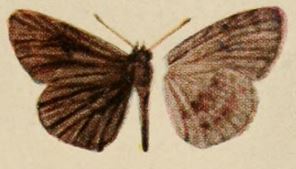
Skippers are a group of butterflies placed in the family Hesperiidae within the order Lepidoptera. They were previously placed in a separate superfamily, Hesperioidea; however, the most recent taxonomy places the family in the superfamily Papilionoidea, the butterflies. They are named for their quick, darting flight habits. Most have their antenna tips modified into narrow, hook-like projections. Moreover, skippers mostly have an absence of wing-coupling structure available in most moths. More than 3500 species of skippers are recognized, and they occur worldwide, but with the greatest diversity in the Neotropical regions of Central and South America.

The superfamily Papilionoidea contains all the butterflies except for the moth-like Hedyloidea.

Grass skippers or banded skippers are butterflies of the subfamily Hesperiinae, part of the skipper family, Hesperiidae. The subfamily was established by Pierre André Latreille in 1809.

Gegenes nostrodamus, commonly known as the dingy swift, light pygmy skipper, Mediterranean skipper or veloz de las rieras, is a butterfly belonging to the family Hesperiidae. It is found from the Mediterranean Sea, through Anatolia to Turkestan and India.

Parnara naso, the African straight or straight swift, is a skipper butterfly belonging to the family Hesperiidae. It is found on Mauritius, Réunion and Madagascar. The habitat consists of forest margins and anthropogenic environments.

Pelopidas mathias, the dark small-branded swift, small branded swift, lesser millet skipper or black branded swift, is a butterfly belonging to the family Hesperiidae. It is found throughout much of south, southeast and East Asia, and as far as the Philippines. It is also present in tropical Africa and Arabia.

Teniorhinus is a genus of skippers in the family Hesperiidae.

Gegenes pumilio, the pigmy skipper or dark Hottentot, is a butterfly of the family Hesperiidae. It is found from the coasts of the Mediterranean Sea through Anatolia to the Himalaya and south in the whole of Africa.

Fresna nyassae, also known as the variegated Acraea skipper or variegated Acraea hopper, is a species of butterfly in the family Hesperiidae. It is found from Ghana and Kenya to South Africa.

Zenonia zeno, the orange-spotted skipper, orange-spotted bellboy or common bellboy, is a butterfly of the family Hesperiidae. It is found from KwaZulu-Natal, Transvaal, Zimbabwe and Mozambique to eastern Africa and to Nigeria. The habitat consists of forests and coastal bush.

Borbo holtzii, the variable swift, is a butterfly of the family Hesperiidae. It is found in Africa, including south-eastern Senegal, Guinea, Sierra Leone, Liberia, Ivory Coast, Ghana, Nigeria, Gabon, the Republic of the Congo, Angola, Kenya, Tanzania, Malawi, Zambia, Zimbabwe, Mozambique, South Africa and Eswatini. The habitat consists of frost-free savanna.

Gegenes hottentota, the marsh Hottentot skipper, Hottentot skipper or Latreille's skipper, is a butterfly of the family Hesperiidae. It is found in Africa and south-western Arabia. The habitat consists of marshy areas with thick grass, especially in valleys.

Isoteinon abjecta, the abject hopper, is a species of butterfly in the family Hesperiidae. It is found in Senegal, the Gambia, Guinea, Sierra Leone, Liberia, Ivory Coast, Ghana, Togo, Nigeria, Cameroon, the Republic of the Congo, Angola, the Democratic Republic of the Congo (Mayoumbe) and Zambia. The habitat consists of forests and humid Guinea savanna.

The Erionotini are a tribe of skipper butterflies in the subfamily Hesperiinae.

Teniorhinus harona, the arrowhead orange or arrowhead skipper, is a butterfly in the family Hesperiidae. It is found in Angola, the Democratic Republic of the Congo (Shaba), Tanzania, Zambia, Malawi, Mozambique, Zimbabwe and Botswana. The habitat consists of deciduous woodland and Brachystegia woodland.

Teniorhinus ignita, the fiery small fox , is a butterfly in the family Hesperiidae. It is found in Sierra Leone, Liberia, Ivory Coast, Ghana, Nigeria, Cameroon, Gabon, the Republic of the Congo, the Central African Republic, the Democratic Republic of the Congo, western Uganda, western Tanzania and northern Zambia. The habitat consists of forests and woodland.

Teniorhinus niger is a butterfly in the family Hesperiidae first described by Hamilton Herbert Druce in 1910. It is found in Cameroon, Gabon, the Democratic Republic of the Congo and western Uganda.

Teniorhinus watsoni, Watson's small fox, is a butterfly in the family Hesperiidae. It is found in Guinea, Sierra Leone, Liberia, Ivory Coast, Ghana, Nigeria, Cameroon, Gabon and the Republic of the Congo. The habitat consists of forests. The species is associated with rivers and swamps.

Caenides dacela, commonly known as the common recluse, is a species of butterfly in the family Hesperiidae. It is found within the geographical range that stretches from the Basse Casamance in Senegal to Uganda and Kenya, but generally does not penetrate much south of the Equator.













